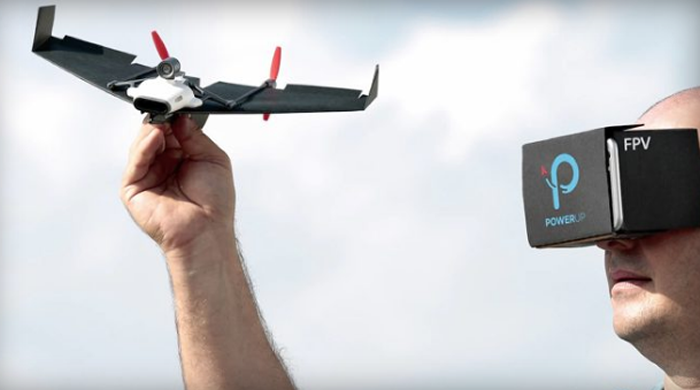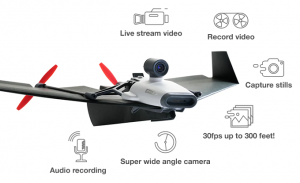With the FPV paper-airplane drone from Powerup Toys, it’s possible to see what it is like on board. Once folded, the paper plane supports a frame that includes control electronics, two motors, a battery, and a tiny camera. There is also a microSD slot for recording your exploits. A boon for do-it-yourself-ers the FPV kit lets you construct, or even design, your own plane. This brings back the challenge of paper airplanes and of drone flying.
Early drones were a real challenge to fly. Not as hard as RC planes, and certainly not as hard as RC helicopters, but they easily went awry. The foam protective shell on my original Parrot AR has the cracks to prove it. Recent models include precise controls, automated flying modes, and even collision avoidance. If you’re looking for a way to get more hands-on with your flying, the new Powerup FPV paper-airplane drone may be perfect for you.
The Powerup FPV kit — designed in partnership with Parrot — includes a power and control unit that pairs with your smartphone, as well as several sheets of large construction paper for building your drone. You can use one of the designs created by the company or other users. You can even create your own. Standard construction paper will work if you run out of the sheets provided.
The FPV pairs with your phone using WiFi. It creates an access point that you need to connect to. Once you’ve done that the Powerup FPV app should be able to find your plane, and you’ll see the image coming from its nose camera. I found this one of the weak points of the system. Often I needed to restart the app, or restart the FPV to get a stable connection. The model I tested is a prototype, so this may have been improved in the final version. The app is fully-released for iOS (on iPhone 5 or later), and is in beta for Android.
For your first flights, you’ll want to have the FPV in its semi-automated mode. Auto Takeoff lets you simply ramp up the throttle, and gently launch the plane. Once it senses motion, the motors kick in — one on each side of the fuselage. It is far easier to do this with two people — one holding the phone and using the app, and the other launching the plane — but it is definitely possible to do by yourself. Similarly, once the plane is in the air, it is helpful to have a second person as a spotter. Otherwise, if you happen to look down at your phone at the wrong time, you may lose track of your plane.
You’ll also want to make sure you have a large, open field. The plane itself is pretty rugged, so crashing into things isn’t so terrible (we did plenty of it), but if it gets stuck high in a tree, you may be out of luck. The FPV has a “find me” chime that sounds automatically when it crash lands, and can be really helpful if it comes down in bushes or leaf litter.
The challenge of building and flying the FPV
The real challenge of flying the FPV is finding a combination of plane design and flight tactics that lets you cruise around and have fun. The simplest design, the Invader, is pretty-easy to fly, but there are some tricks. If your elevators aren’t up enough, you won’t get enough lift. If they are too high, they’ll act as air brakes. It can take some fiddling to get them set right for stable flight. Similarly, it took a couple outings before we realized that, since the FPV turns by lowering the throttle on one of its motors, a tight turn greatly reduced its thrust and lift. So we learned the hard way to only make gentle turns when near the ground. Since the plane flies fast at full throttle, that’s yet another reason to launch in a large field.
The effective range of the FPV is limited by its 2.4GHz WiFi. In some cases it would respond well up to 100 yards away, but in others we started to lose control at distances less than that. Obviously, that will be affected by your phone model and how many other WiFi devices are nearby.
It’s a flying camera
The FPV Invader isn’t too different from this 1967 design I built as a child — from The Great International Paper Airplane BookThe FPV sets itself apart from Powerup’s less expensive paper-airplane models with its camera and integrated audio and video streaming. You can see what the plane sees as you fly, and tell it to record its video to a microSD card (presumably this is an Android-specific feature). This is fun, although since you really need to be flying the FPV in an open field, there is a limit to how exciting your footage is likely to be. Video quality is good, but of course not what you’d get with a more-expensive DJI model. Here’s the footage from one of our early flights: The FPV has a VGA-resolution camera, (although I found that it was more consistent in its lower-quality 320 x 240 mode). The plane’s battery is rated for 10 minutes of flight, but we had better luck swapping out the 550 mAh Lipo battery more often than that. “VR” mode: First-person flying The biggest reason the FPV is unique is that you can actually fly it using the (included) Google Cardboard-compatible headset. In this mode, the plane responds to your head movements. Powerup recommends using a large-screen phone (like the iPhone 6 Plus or 7 Plus) for this mode, and definitely having a second person with you to act as a spotter. Once you have it working you get a taste of what it would feel like to pilot a racing drone — at a fraction of the cost. The Powerup FPV started out as a Kickstarter project, but is becoming available through retailers at $199 — although right now it seems to be in short supply. If you are curious about the idea of making your own drones out of paper airplanes, but don’t need all the features of the FPV, Powerup’s 3.0 model has a single motor and no camera, for $50.
More information: ExtremeTech



Comments are closed, but trackbacks and pingbacks are open.